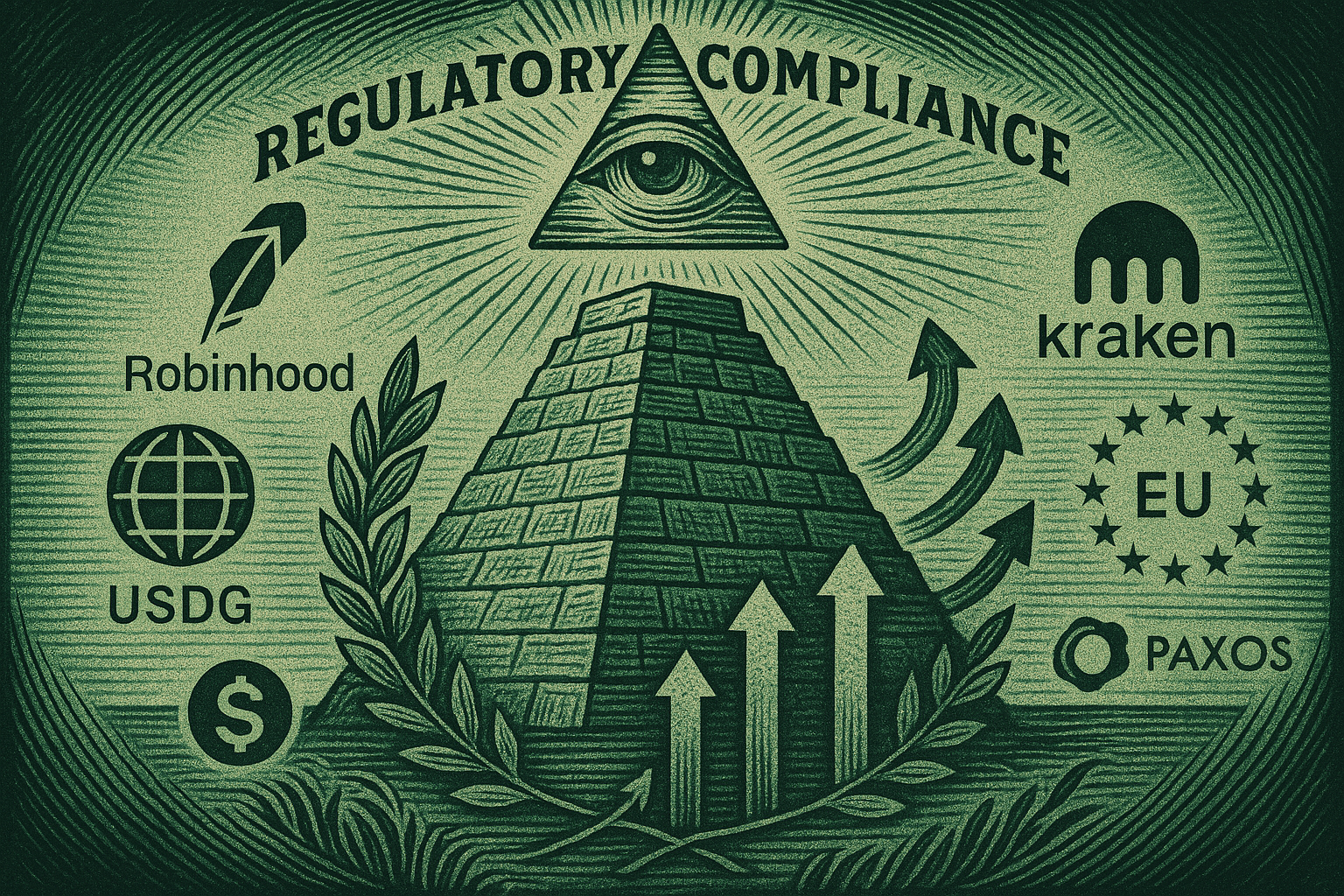Wait, another dollar-pegged coin? Didn’t we already max out the stablecoin menu?
That was literally my first thought when I skimmed the headline: “Robinhood, Kraken-Backed Global Dollar (USDG) Comes to Europe.” There are already more dollar-tracking tokens than coffee flavors at Starbucks, so why toss another one into the blender? But the rabbit hole goes deeper than garden-variety hype, so let’s unpack it.
Here’s what actually happened
Paxos — yeah, the same Paxos Trust Company that minted USDP and (RIP) BUSD for Binance — just announced USDG, a fully regulated global USD stablecoin. It’s supposedly MiCA-ready out of the gate, meaning it already meets those shiny new European rules that scare half of crypto Twitter.
The eyebrow-raiser? Robinhood and Kraken Digital Asset Exchange are early backers. Both platforms plan to list USDG for their EU customers “in the coming weeks,” according to two people who are always “familiar with the matter.” Paxos says the coin is 100% cash + short-term U.S. Treasury bills in segregated accounts and will publish monthly attestations. In other words, they’re leaning into the regulatory flex.
Why should any of us care?
Quick reality check: Tether’s USDT still dominates with a $110B market cap; Circle’s USDC sits around $34B. Anyone launching a fresh dollar-peg in 2024 is either delusional or has an angle. Paxos’ angle is crystal clear: compliance tourism. MiCA (Markets in Crypto-Assets) kicks in for “stablecoins referencing a currency” in June 2024 in the EU, and most issuers are scrambling. Paxos is basically yelling, “Yo European regulators, we did our homework first — pick us!”
If that pitch lands, exchanges that operate in the EU — hello Bitstamp, Bitpanda, Coinbase EU desks — will need a compliant on-ramp. That potentially funnels billions of euros’ worth of buy-side demand into USDG rather than USDT, which still hasn’t offered a full MiCA playbook.
But wait, didn’t Paxos get slapped by the SEC last year?
Yep. February 2023, Paxos received a Wells notice over BUSD. Binance’s brand was the problem, not necessarily Paxos’ custody model, but it left a scar. Some folks see USDG as Paxos’ redemption tour: ditch the Binance baggage, go extra transparent, and win back regulators in one of the strictest arenas on the planet.
Show me the receipts
- Total initial mint: $5 million USDG (on Ethereum) hit the chain at launch, according to Etherscan.
- Paxos promised monthly reserve attestations audited by Withum — same firm Circle uses.
- MiCA requires a 2% reserve buffer on top of 100% backing. Paxos says they’ll overcollateralize “as needed,” although the docs were light on exact ratios.
- Stablecoin market in Europe is still mostly USDT/USDC pairs: Kaiko’s Q1 report showed 92% of EUR spot volume still settled in USDT.
Okay, but is Robinhood’s European push even a big deal?
Honestly, I used to shrug at Robinhood Crypto until they started quietly snagging licenses: they’ve got the DASP registration in France and just rolled out Robinhood Wallet globally. Combine that with Kraken’s heavyweight status (they processed $207B in spot volume last year, per The Block Research), and you’ve got two nicely-capitalized funnels pointing at USDG day one.
Possible curveballs I’m watching
1. Liquidity depth. No trader wants slippage hell. If market makers don’t swarm quickly, USDG becomes another “looks good on paper” ghost town.
2. On-chain composability. DeFi protocols like Aave and Curve have woken up to MiCA. If they whitelist USDG pools early, that’s instant utility. If not, the coin stays centralized-exchange-only — yawn.
3. Regulatory whiplash in the U.S. If the SEC decides to broaden its “stablecoin as security” thesis, anything with a U.S. nexus (Paxos is NY-chartered) could get tangled again. European approval won’t save them from Gary Gensler’s cross-atlantic vibes.
Why this matters for your portfolio (even if you’re not in the EU)
Here’s the selfish take: more compliant on-ramps usually mean tighter spreads and better fiat exits. If USDG gains trust, U.S. traders might find arbitrage routes versus USDC or USDT, especially when funding rates diverge. I’m already picturing clever folks setting up USDG-USDC flash loan loops the minute Curve adds a tri-pool.
Also, a MiCA-blessed stablecoin sets precedent. If EU regulators pat USDG on the head, Circle and Tether will have to match transparency or risk delistings from every exchange operating under an EU VASP license. That’s a potential shake-up for the $150B stablecoin pie.
“Regulation is the ultimate network effect.” — Some crypto lawyer I follow on BlueSky
Random tangent: remember Libra?
I can’t help giggling at how USDG’s playbook echoes Facebook’s doomed Libra (later Diem) dream: a single, regulator-friendly global dollar for cross-border payments. The difference? Paxos isn’t fighting headlines about Mark Zuckerberg’s poker-face testimony. Sometimes low-key beats flashy.
So, am I aping in?
I’ll test the waters once liquidity clears $100M. Until then, I’m parking dry powder in tried-and-true USDC and, yes, a little USDT because old habits die hard. But I’m adding USDG to my watchlist — mainly because MiCA compliance feels like the next meta, and being early never hurts.
Final thought: Every cycle, we get a new “most compliant stablecoin ever.” The difference this time is real regulatory teeth in Europe. If USDG nails gears-up-ready, we might witness the first truly borderless yet regulator-approved dollar on-chain. Or it fizzles and joins the graveyard with Gemini Dollar. Either way, pass the popcorn.



